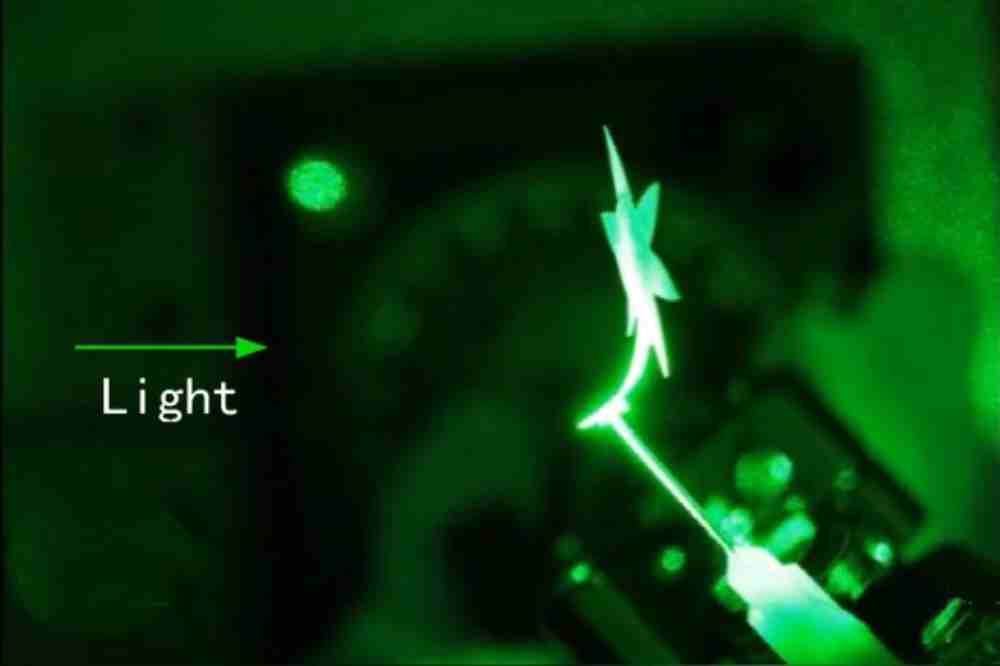Iridescent butterfly wings are made of regular nanoscale lattices called photonic crystals. The angle at which the light meets the wing's “crystalline” structure can affect which wavelengths are absorbed — hence, a butterfly's many beautiful colors.
Taking inspiration from the insect, researchers at Tufts University School of Engineering have created light-activated composite devices that execute precise, visible movements and form complex three-dimensional shapes, without the need for wires or other actuating materials or energy sources.
What kinds of 3D designs are possible exactly?
The Tufts team created a “photonic sunflower.” The flower's petals curl towards and away from illumination, tracking the path and angle of the light.
The researchers' demonstrations of the material also included a self-folding box, as a well a butterfly whose wings opened and closed in response to light.
The nano-engineered designs, which combines programmable photonic crystals with an elastomeric composite, enable the development of new kinds of light-driven systems, such as self-aligning solar cells, light-actuated microfluidic valves, and soft robots that move with light on demand.
The study appeared the March 12th, 2021 edition of Nature Communications .
The photonic material designed by the Tufts team joins two layers: an opal-like film made of silk fibroin doped with gold nanoparticles (AuNPs), forming photonic crystals, and an underlying substrate of polydimethylsiloxane (PDMS), a silicon-based polymer.
The flexible, durable silk fibroin has a negative coefficient of thermal expansion (CTE), meaning that it contracts when heated and expands when cooled.
PDMS, by contrast, has a high CTE and expands rapidly when heated.
As a result, when the novel material is exposed to light, one layer heats up much more rapidly than the other. The material bends as one side expands and the other contracts.
“With our approach, we can pattern these opal-like films at multiple scales to design the way they absorb and reflect light. When the light moves and the quantity of energy that’s absorbed changes, the material folds and moves differently as a function of its relative position to that light,” said Fiorenzo Omenetto, study author Professor of Engineering at Tufts.
Omenetto and the Tufts researchers used stencils — and exposed those stencils to water vapor— to program the photonic crystal films and generate specific patterns, like those required to make a sunflower. The surface water patterns altered the wavelength of absorbed and reflected light from the film, thus causing the material to bend in different ways, depending on the geometry of the pattern, when exposed to laser light.
The “photonic sunflower” featured integrated solar cells in the bilayer film so that the cells tracked the light source. The device kept the same angle between the solar cells and the laser beam, maximizing the cells’ efficiency as the light moved.
In a short Q&A below, Omenetto explains more about why such wireless, light-responsive devices could enhance efficiency for the solar industry and open up a variety of other valuable applications.
Tech Briefs: What criteria did you use for choosing the patterns? Do you choose the pattern for a specific action that would have a specific application? Why did you choose biological patterns like a sunflower and a butterfly?
Prof. Fiorenzo Omenetto: We did not have any specific guidelines in the choice of the patterns except to pick particular designs that would exemplify the range of possible (opto)mechanical deformations achievable. The choice of a sunflower and a butterfly are driven by natural inspiration: the sunflower for its capacity to reorient and follow the sun, the butterfly as one of the signature examples of structural color found in nature, both recapitulated in the materials that we make.
Tech Briefs: How specific can these patterns get? What is this stencil exactly that enables specific shapes like a sunflower, and how does that stencil enable specific patterns?
Prof. Fiorenzo Omenetto: The patterns can be as specific as one wants them to be. The stencil serves as a mask to expose different portions of the material to humidity (or to UV light), and to tune the absorption/reflectivity of the exposed portion accordingly. Once the pattern is set, the redistribution of light within the material does the rest.
Tech Briefs: Is the force of the mechanical response a function of the energy of the incident light?
Prof. Fiorenzo Omenetto: Strictly speaking, the speed of actuation is dependent on the dynamics of heating (fast heating, faster system response).
Tech Briefs: What has been used previously to convert light energy into movement?
Prof. Fiorenzo Omenetto: Generally speaking, almost all optomechanical systems fall into two categories of working mechanisms: photothermal and photochemical, be they hydrogels, bilayers, or liquid crystal elastomers. Also reconfigurable strips have been reported in several occasions especially in liquid crystal elastomers. However, current strategies and concepts for this purpose are predominately optimizing molecular structure and assembly of the materials.
Tech Briefs: Aside from solar cells, what kinds of applications do you envision with this kind of design?
Prof. Fiorenzo Omenetto: We think this is up to anyone’s imagination, from lamp shades that change shape, to valves that can be opened and closed by shining light on them, to shape shifting materials that could be used for soft robotics.
Tech Briefs: Why is this achievement an important one?
Prof. Fiorenzo Omenetto: We exploit the intrinsic properties of self-assembled photonic crystals — photonic bandgap — to control the light propagation path within the material and, thus, the light-energy conversion, to realize direction-dependent actuation (the angular dependence of the material response comes from the angular dependence of the optical response), complex shape morphing, phototropism, and configurable actuation which is challenging to obtain in a single material.
We showed how to achieve complex deformation on the macroscale by manipulating the photonic response on the nanoscale.
What do you think? Share your questions and comments below.
Transcript
No transcript is available for this video.


